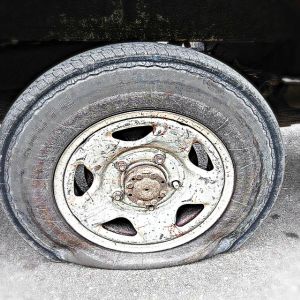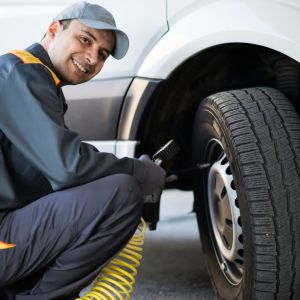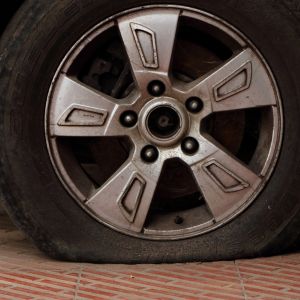Driving on punctured tyres can be extremely dangerous, as it can lead to a loss of control of the vehicle and increase the risk of an accident. A punctured tyre will have less air pressure, which means it will have less traction and will take longer to stop the vehicle; this can be especially dangerous in wet or slippery conditions.
Additionally, driving on punctured tyres can cause damage to the vehicle’s suspension and steering components, which can lead to costly repairs. The tyre may also cause bulging or blowout, leading to a complete loss of control of the vehicle, which can be life-threatening.
The effects of driving on punctured tyres

Here we discuss about effects of driving on punctured tyres. Have a look at them.
Prone to blunders: A punctured tyre can be dangerous because it can cause the vehicle to lose control or blow out, resulting in an accident.
Reduced traction: When a tyre is punctured, air pressure is lost and the tyre’s ability to grip the road surface is reduced. This can make controlling the vehicle difficult, especially in wet or slick conditions.
Increased stopping distance: A punctured tyre will have less air pressure, resulting in less traction and a longer stopping distance.
Damage to the tyre: Driving on a punctured tyre can result in additional tyre damage such as sidewall bulging or a complete blowout. This can result in the vehicle losing control completely.
Vehicle damage: A punctured tyre can cause damage to the vehicle’s suspension and steering components, resulting in costly repairs.
Increased fuel consumption: A punctured tyre increases rolling resistance, causing the vehicle to work harder, resulting in increased fuel consumption and decreased fuel efficiency.
Reduced tyre life: Driving on a punctured tyre can cause excessive wear and tear on the tyre, reducing its lifespan and necessitating its replacement sooner.
When to replace the punctured tyres?

When you notice damage to the tyre, such as cuts, sidewall bulging, or excessive wear, it should be replaced. Driving a vehicle with a damaged tyre or on punctured tyres is not safe; it can cause a variety of mishaps and is dangerous to drive in. It can jeopardise the driver’s and passengers’ safety by resulting in a serious accident. It is critical to replace the punctured tyre as soon as possible.
Minor damage, such as a car puncture in the tread, can be repaired by a professional mechanic; however, if the problem persists and the tyre’s quality deteriorates after repair, it is recommended that the tyre be replaced as soon as possible.
If you are unable to have the tyre checked or replaced right away, you should slow down and avoid making sudden turns or brakes to avoid causing further damage to the tyre or increasing the risk of an accident.
The fastest speed that is achieved with a punctured tyre

On a flat tyre, the maximum speed is approximately 80 km/h. Driving on a flat tyre at any speed, on the other hand, is extremely dangerous. A flat tyre significantly reduces traction and stability, making vehicle control more difficult. The tyre will also have much less air pressure, which means less cushioning and more rolling resistance, making the vehicle work harder and use less fuel. A flat tyre can also damage the vehicle’s suspension and steering components, resulting in costly repairs.
Driving on punctured tyres increases the risk of a blowout, which can result in total loss of control vehicle and a serious accident. If you have a flat tyre while driving, you should pull over and replace it as soon as possible to ensure your safety and the safety of other drivers on the road.
Accidents caused due to driving on punctured tyres
Driving on punctured tyres can result in a number of accidents, including:
- Control loss: A punctured tyre can cause the vehicle to lose control, particularly in wet or slick conditions. This can result in a rollover or a collision with another vehicle or object.
- Blowouts: A punctured tyre can result in a blowout, which occurs when the tyre abruptly loses all of its air pressure. This can cause the vehicle to veer off the road or spin out of control.
- Reduced braking ability: A punctured tyre will have less air pressure, resulting in less traction and a longer stopping distance. This can result in rear-end collisions or other accidents.
- Reduced visibility: A punctured tyre can cause debris to fly up and strike the vehicle, causing damage to the windscreen or other parts of the vehicle as well as a problem with visibility for the driver.
- Reduced stability: A punctured tyre can make the vehicle unstable, increasing the likelihood that it will roll over or tip over.
Frequently Asked Questions
Q1. Can driving on a flat tyre cause damage?
Ans: Yes, driving on a flat tyre can result in damage.
Q2. How long can you drive on a damaged tyre?
Ans: Driving on a damaged tyre is not advised.
Q3. What’s the fastest you can drive on a flat tyre?
Ans: The maximum speed you can drive on a flat tyre is approximately 50 miles per hour.

